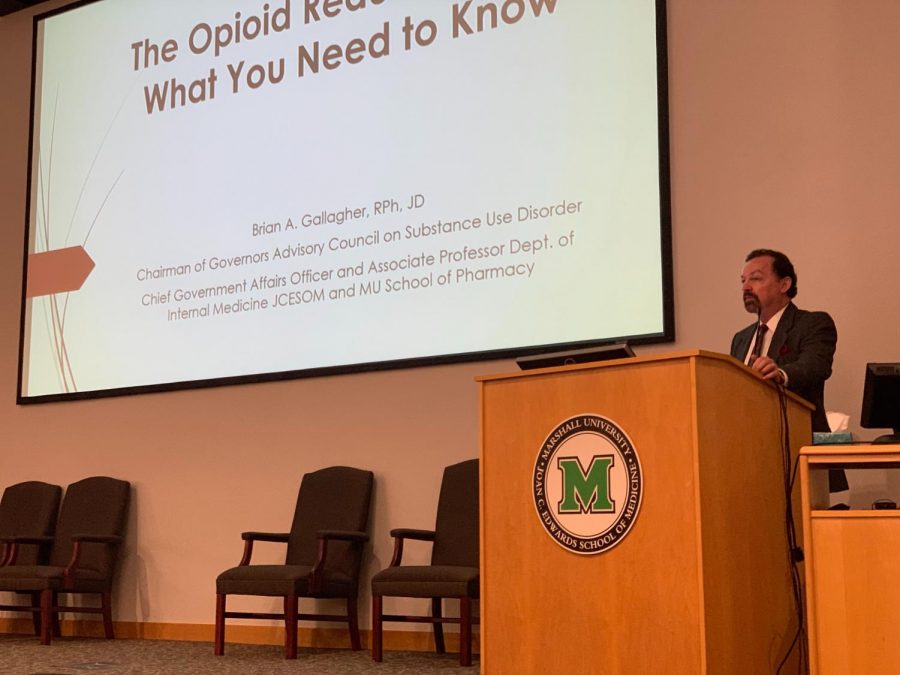Healthcare officials discuss impact of ‘Opioid Reduction Act’ on West Virginia
Dr. Brian A. Gallagher, chairman of the Governor’s Advisory Council on Substance Use Disorder, addresses an auditorium of healthcare professionals at Cabell Huntington Hospital Aug. 28.
Healthcare officials from throughout West Virginia discussed how House Bill 2768 would affect opioid prescriptions in the state during a meeting at Cabell Huntington Hospital in Huntington Wednesday, Aug. 28.
HB 2768, also known as the Opioid Reduction Act, passed March 9 and went into effect 90 days after. The bill attempts to reduce the number of opioid prescriptions in the state of West Virginia by placing prescription limitations on numerous healthcare professionals.
According to the bill, practitioners, other than a dentist or an optometrist, may not issue an initial Schedule II opioid drug prescription for more than a seven-day supply, and the prescription shall also be for the lowest effective dose. An initial prescription is a prescription that has not been given to the patient within the last year.
There are exceptions to the bill, such as patients currently in active treatment for cancer, patients receiving hospice care, long-term patients of a healthcare facility and patients who were already engaged in a practitioner-patient relationship before Jan. 1, 2018.
“Without any question, this act will go a long way to reduce the overall cases of people who take these drugs legitimately and become addicted. However, it doesn’t affect those who are already addicted,” Brian Gallagher, chairman of the Governor’s Advisory Council on Substance Use Disorder and assistant professor of pharmacy practice, administration, and research with the School of Pharmacy, said. “What we talk about on the Governor’s Advisory Council is how we need to throw the ball to the base where the runner is running and not to the base where the runner has come from.”
Prior to issuing a seven-day supply of a Schedule II opioid prescription, HB 2768 requires practitioners to document a thorough medical history of the patient, conduct a physical examination, develop a treatment plan with a focus on determining the patient’s pain and access the Controlled Substances Monitoring Program, a database that tracks all controlled substance prescriptions in the state. After the seven-day supply, a subsequent prescription may be prescribed if a practitioner believes it to be rational and continues to access the Controlled Substances Monitoring Program.
The bill also requires patients to enter into a narcotics contract with their prescribing practitioner after the issuance of the third prescription for a Schedule II opioid. By signing this contract, the patients agree to obtain scheduled medications from only their prescribing practitioner, to fill those prescriptions at a single pharmacy and to notify the prescribing practitioner within 72 hours of any emergency if they are prescribed scheduled medication. If for any reason the patients fails to honor the contract, the practitioner may either terminate the treatment, or continue treatment without the use of schedule II opioids.
Some healthcare officials such as Gallagher are concerned there has been too much of an emphasis on opioid prescriptions and not enough attention towards the broader issue of drug addiction that is occurring throughout the state. Even with the recent attempts to lower the use of Schedule II opioid prescriptions, drug addiction continues to increase.
“With the major crackdown on opioid prescriptions, many of those suffering from addiction are now just turning to drugs like methamphetamine and heroin,” Gallagher said. “So, it’s not just opioid prescriptions that are responsible for the problems in this state.”
Gallagher suggested the state should begin to think about creating policy inspired by former President Franklin D. Roosevelt’s New Deal, which provided a series of public-projects and programs aimed at responding to those in the country who were in need of relief.
HB 2768 also places a focus on using alternative treatments for pain such as acupuncture, physical therapy, occupational therapy, massage therapy and osteopathic manipulation. However, the bill does not enforce that practitioners exhaust all options of alternative treatment before prescribing a Schedule II opioid prescription.
Another concern surrounding HB 2768 is if the crackdown on Schedule II opioids is possibly placing an undue burden on those who are in legitimate need of the medication. Healthcare officials have expressed concern over their ability to properly prescribe medication to those who are in need of treatment.
“There are people out there who need these drugs, and I hear the many concerns from practitioners who are worried about not being able to properly prescribe their patients medication,” Gallagher said. “Healthcare professionals and practitioners across the state need to ask themselves, has the pendulum swung too far?”
Blake Newhouse can be contacted at [email protected].
Your donation will help continue the work of independent student journalism at Marshall University. If you benefit from The Parthenon's free content, please consider making a donation.





